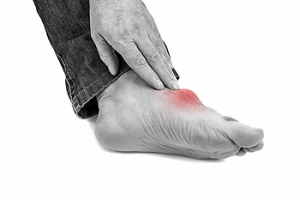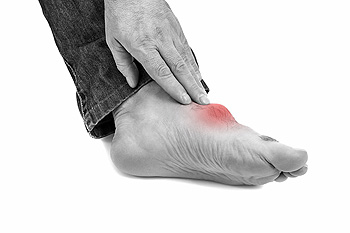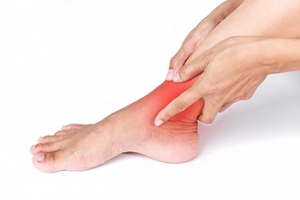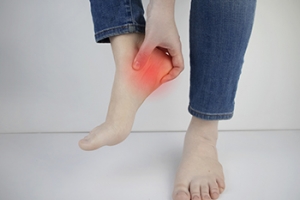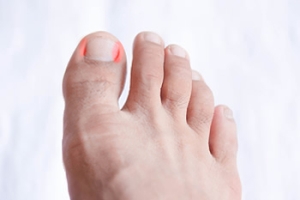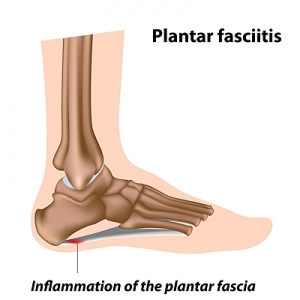Super User
Why You Should Treat Your Gout
Many people experience occasional gout attacks. These flare ups cause sudden, severe pain, swelling, and warmth in the affected joint that usually last between 3 and 10 days. Once the gout attack ends, the symptoms subside - at least until the next gout attack. If the severe pain of a flare up is not reason enough to seek medical care, it is important to remember the risk of gout becoming chronic if it is left untreated. Gout is a form of arthritis. When steps are not taken to treat this condition, hard lumps called tophi can develop in your joints, skin, and surrounding tissues, causing permanent joint damage and swelling. Managing the symptoms of gout and preventing future attacks are the main goals of treatment. To learn more about gout, please consult with a podiatrist.
Gout is a foot condition that requires certain treatment and care. If you are seeking treatment, contact the foot specialists from Table Mountain Foot and Ankle. Our doctors will treat your foot and ankle needs.
What Is Gout?
Gout is a type of arthritis caused by a buildup of uric acid in the bloodstream. It often develops in the foot, especially the big toe area, although it can manifest in other parts of the body as well. Gout can make walking and standing very painful and is especially common in diabetics and the obese.
People typically get gout because of a poor diet. Genetic predisposition is also a factor. The children of parents who have had gout frequently have a chance of developing it themselves.
Gout can easily be identified by redness and inflammation of the big toe and the surrounding areas of the foot. Other symptoms include extreme fatigue, joint pain, and running high fevers. Sometimes corticosteroid drugs can be prescribed to treat gout, but the best way to combat this disease is to get more exercise and eat a better diet.
If you have any questions please feel free to contact our office located in Wheat Ridge, CO . We offer the newest diagnostic and treatment technologies for all your foot and ankle needs.
What Is Causing My Ankle Pain?
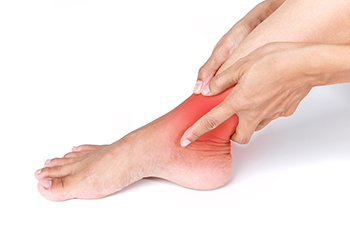 The ankle joint is designed to support the whole body through a complex network of bones, muscles, cartilage, ligaments and tendons. Injury or disease to any one of these parts can be debilitating. One of the most common forms of ankle pain is from an ankle sprain. Ankle sprains often occur from stepping on an uneven surface or from a sporting accident that causes the ligaments connecting the bones to become partially or completely torn. Tendonitis is another common cause of ankle pain. Tendonitis occurs when the tendons, which connect the muscles to the bones, become inflamed. Arthritis, which occurs when joints become inflamed, can also lead to ankle pain. There are a variety of other sources of ankle pain, and patients who notice pain in their ankle should consult with a podiatrist for a proper diagnosis and treatment.
The ankle joint is designed to support the whole body through a complex network of bones, muscles, cartilage, ligaments and tendons. Injury or disease to any one of these parts can be debilitating. One of the most common forms of ankle pain is from an ankle sprain. Ankle sprains often occur from stepping on an uneven surface or from a sporting accident that causes the ligaments connecting the bones to become partially or completely torn. Tendonitis is another common cause of ankle pain. Tendonitis occurs when the tendons, which connect the muscles to the bones, become inflamed. Arthritis, which occurs when joints become inflamed, can also lead to ankle pain. There are a variety of other sources of ankle pain, and patients who notice pain in their ankle should consult with a podiatrist for a proper diagnosis and treatment.
Ankle pain can be caused by a number of problems and may be potentially serious. If you have ankle pain, consult with the foot specialists from Table Mountain Foot and Ankle. Our doctors will assess your condition and provide you with quality foot and ankle treatment.
Ankle pain is any condition that causes pain in the ankle. Due to the fact that the ankle consists of tendons, muscles, bones, and ligaments, ankle pain can come from a number of different conditions.
Causes
The most common causes of ankle pain include:
- Types of arthritis (rheumatoid, osteoarthritis, and gout)
- Ankle sprains
- Broken ankles
- Achilles tendinitis
- Achilles tendon rupture
- Stress fractures
- Bursitis
- Tarsal tunnel syndrome
- Plantar fasciitis
Symptoms
Symptoms of ankle injury vary based upon the condition. Pain may include general pain and discomfort, swelling, aching, redness, bruising, burning or stabbing sensations, and/or loss of sensation.
Diagnosis
Due to the wide variety of potential causes of ankle pain, podiatrists will utilize a number of different methods to properly diagnose ankle pain. This can include asking for personal and family medical histories and of any recent injuries. Further diagnosis may include sensation tests, a physical examination, and potentially x-rays or other imaging tests.
Treatment
Just as the range of causes varies widely, so do treatments. Some more common treatments are rest, ice packs, keeping pressure off the foot, orthotics and braces, medication for inflammation and pain, and surgery.
If you have any questions, please feel free to contact our office located in Wheat Ridge, CO . We offer the newest diagnostic and treatment technologies for all your foot care needs.
Ankle Pain
Pain experienced in the ankle can be caused by a multitude of conditions. While the most common cause is an ankle sprain, other possible problems can include arthritis, gout, ankle instability, an ankle fracture, nerve compression, or tendinitis. In more serious cases, ankle pain can be a sign of improper alignment of the foot or an infection.
Ankle pain can often be accompanied by symptoms such as redness, swelling, stiffness, and warmth in the affected area. Pain can be described differently depending on the condition: short, stabbing pain and a dull ache are some examples. If such symptoms are persistent and do not improve after time, be sure to schedule an appointment with your local podiatrist.
Depending on the condition causing your ankle pain, different treatments may be prescribed by your podiatrist. For ankle sprains, the first step in treatment involves rest, ice, elevation, and compression. Be sure to avoid placing pressure on the ankle, use an ice pack several times a day, and use a compression bandage and elevation to reduce swelling. Other, more serious conditions may require the assistance of certain drugs and medications such as nonsteroidal anti-inflammatory drugs (NSAIDs), physical therapy, or even cortisone injections.
Depending on the severity of your ankle pain and the condition behind it, recovery from ankle pain may take some time.
Consult with your foot and ankle doctor to best determine the cause of your ankle pain and the appropriate treatment.
Treating the Causes of Plantar Fasciitis
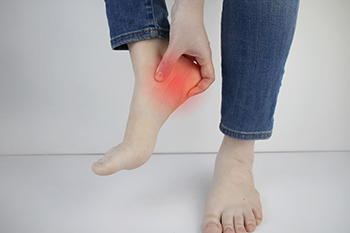 Plantar fasciitis is a common injury in which the plantar fascia, a ligament that runs along the bottom of the foot and connects the heel bone to the toes, becomes overstretched and inflamed. When it comes to treating this condition, the first step is to determine what has caused the plantar fascia to overstretch. Sometimes this is caused by overpronation, a walking pattern common in people with flat feet in which the foot rolls too far inwards. It may also be caused by unusually high arches in the midfoot. These issues can both be corrected using orthotics. When plantar fasciitis is caused by overuse from playing sports, running, or frequently doing exercises that put stress on the feet, taking time to rest and recover, ensuring that you are wearing the appropriate shoes, and losing excess weight can all potentially help relieve symptoms. If you are suffering from heel or arch pain, it is suggested that you seek the care of a podiatrist.
Plantar fasciitis is a common injury in which the plantar fascia, a ligament that runs along the bottom of the foot and connects the heel bone to the toes, becomes overstretched and inflamed. When it comes to treating this condition, the first step is to determine what has caused the plantar fascia to overstretch. Sometimes this is caused by overpronation, a walking pattern common in people with flat feet in which the foot rolls too far inwards. It may also be caused by unusually high arches in the midfoot. These issues can both be corrected using orthotics. When plantar fasciitis is caused by overuse from playing sports, running, or frequently doing exercises that put stress on the feet, taking time to rest and recover, ensuring that you are wearing the appropriate shoes, and losing excess weight can all potentially help relieve symptoms. If you are suffering from heel or arch pain, it is suggested that you seek the care of a podiatrist.
Plantar fasciitis is a common foot condition that is often caused by a strain injury. If you are experiencing heel pain or symptoms of plantar fasciitis, contact the foot specialists from Table Mountain Foot and Ankle. Our doctors can provide the care you need to keep you pain-free and on your feet.
What Is Plantar Fasciitis?
Plantar fasciitis is one of the most common causes of heel pain. The plantar fascia is a ligament that connects your heel to the front of your foot. When this ligament becomes inflamed, plantar fasciitis is the result. If you have plantar fasciitis you will have a stabbing pain that usually occurs with your first steps in the morning. As the day progresses and you walk around more, this pain will start to disappear, but it will return after long periods of standing or sitting.
What Causes Plantar Fasciitis?
- Excessive running
- Having high arches in your feet
- Other foot issues such as flat feet
- Pregnancy (due to the sudden weight gain)
- Being on your feet very often
There are some risk factors that may make you more likely to develop plantar fasciitis compared to others. The condition most commonly affects adults between the ages of 40 and 60. It also tends to affect people who are obese because the extra pounds result in extra stress being placed on the plantar fascia.
Prevention
- Take good care of your feet – Wear shoes that have good arch support and heel cushioning.
- Maintain a healthy weight
- If you are a runner, alternate running with other sports that won’t cause heel pain
There are a variety of treatment options available for plantar fasciitis along with the pain that accompanies it. Additionally, physical therapy is a very important component in the treatment process. It is important that you meet with your podiatrist to determine which treatment option is best for you.
If you have any questions, please feel free to contact our office located in Wheat Ridge, CO . We offer the newest diagnostic and treatment technologies for all your foot care needs.
What Can Cause an Ingrown Toenail?
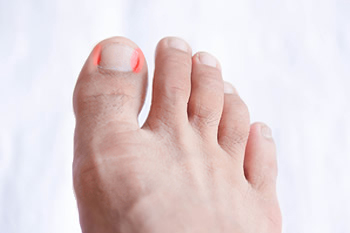 An ingrown toenail is defined as a nail that grows into the outside edges of the skin. It generally affects the big toe and can cause severe pain and discomfort. It can occur as a result of wearing shoes that do not have adequate room for the toes to move freely in, or possibly from genetic factors. Additionally, the shape of the nail may be conducive to developing an ingrown toenail. Research has indicated that ingrown toenails may happen more often in children and pregnant women. This can be a result of the accelerated speed of the nail growth. Mild relief may be found when the affected toe is soaked in warm water which can be beneficial in pulling the nail away from the softened skin. An ingrown toenail can easily become infected if not promptly treated. If you are afflicted with this ailment it is strongly suggested that you speak with a podiatrist who can properly treat this condition.
An ingrown toenail is defined as a nail that grows into the outside edges of the skin. It generally affects the big toe and can cause severe pain and discomfort. It can occur as a result of wearing shoes that do not have adequate room for the toes to move freely in, or possibly from genetic factors. Additionally, the shape of the nail may be conducive to developing an ingrown toenail. Research has indicated that ingrown toenails may happen more often in children and pregnant women. This can be a result of the accelerated speed of the nail growth. Mild relief may be found when the affected toe is soaked in warm water which can be beneficial in pulling the nail away from the softened skin. An ingrown toenail can easily become infected if not promptly treated. If you are afflicted with this ailment it is strongly suggested that you speak with a podiatrist who can properly treat this condition.
Ingrown toenails can become painful if they are not treated properly. For more information about ingrown toenails, contact the foot specialists of Table Mountain Foot and Ankle. Our doctors can provide the care you need to keep you pain-free and on your feet.
Ingrown Toenails
Ingrown toenails occur when a toenail grows sideways into the bed of the nail, causing pain, swelling, and possibly infection.
Causes
- Bacterial infections
- Improper nail cutting such as cutting it too short or not straight across
- Trauma to the toe, such as stubbing, which causes the nail to grow back irregularly
- Ill-fitting shoes that bunch the toes too close together
- Genetic predisposition
Prevention
Because ingrown toenails are not something found outside of shoe-wearing cultures, going barefoot as often as possible will decrease the likeliness of developing ingrown toenails. Wearing proper fitting shoes and using proper cutting techniques will also help decrease your risk of developing ingrown toenails.
Treatment
Ingrown toenails are a very treatable foot condition. In minor cases, soaking the affected area in salt or antibacterial soaps will not only help with the ingrown nail itself, but also help prevent any infections from occurring. In more severe cases, surgery is an option. In either case, speaking to your podiatrist about this condition will help you get a better understanding of specific treatment options that are right for you.
If you have any questions please feel free to contact our office located in Wheat Ridge, CO . We offer the newest diagnostic and treatment technologies for all your foot and ankle needs.
What Causes Plantar Fasciitis?
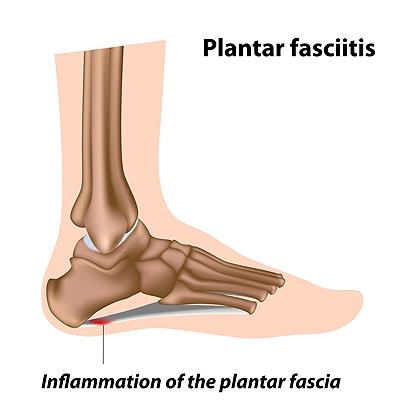 Plantar fasciitis is the most common source of heel pain. It occurs when the plantar fascia, the band of tissue running along the bottom of the foot that connects the heel to the toes, becomes inflamed. Plantar fasciitis is usually a result of repetitive overstretching of the plantar fascia. Common contributing factors include having high arches or flat feet, standing on hard surfaces for a long period of time, age (between 40 and 60), being overweight, wearing high heels, and a sudden change in activity level. Plantar fasciitis pain is most prevalent in the middle of the heel and it is usually worse after waking up in the morning or after taking a long rest. Patients who are experiencing heel pain should consult with a podiatrist for a proper diagnosis and to determine what route of treatment should be implemented.
Plantar fasciitis is the most common source of heel pain. It occurs when the plantar fascia, the band of tissue running along the bottom of the foot that connects the heel to the toes, becomes inflamed. Plantar fasciitis is usually a result of repetitive overstretching of the plantar fascia. Common contributing factors include having high arches or flat feet, standing on hard surfaces for a long period of time, age (between 40 and 60), being overweight, wearing high heels, and a sudden change in activity level. Plantar fasciitis pain is most prevalent in the middle of the heel and it is usually worse after waking up in the morning or after taking a long rest. Patients who are experiencing heel pain should consult with a podiatrist for a proper diagnosis and to determine what route of treatment should be implemented.
Plantar fasciitis can be very painful and inconvenient. If you are experiencing heel pain or symptoms of plantar fasciitis, contact the foot specialists from Table Mountain Foot and Ankle. Our doctors can provide the care you need to keep you pain-free and on your feet.
What Is Plantar Fasciitis?
Plantar fasciitis is the inflammation of the thick band of tissue that runs along the bottom of your foot, known as the plantar fascia, and causes mild to severe heel pain.
What Causes Plantar Fasciitis?
- Excessive running
- Non-supportive shoes
- Overpronation
- Repeated stretching and tearing of the plantar fascia
How Can It Be Treated?
- Conservative measures – anti-inflammatories, ice packs, stretching exercises, physical therapy, orthotic devices
- Shockwave therapy – sound waves are sent to the affected area to facilitate healing and are usually used for chronic cases of plantar fasciitis
- Surgery – usually only used as a last resort when all else fails. The plantar fascia can be surgically detached from the heel
While very treatable, plantar fasciitis is definitely not something that should be ignored. Especially in severe cases, speaking to your doctor right away is highly recommended to avoid complications and severe heel pain. Your podiatrist can work with you to provide the appropriate treatment options tailored to your condition.
If you have any questions please feel free to contact our office located in Wheat Ridge, CO . We offer the newest diagnostic and treatment technologies for all your foot and ankle needs.
How Serious Is Turf Toe?
 Turf toe is an injury that can frequently affect athletes who play football, baseball, or soccer as a result of playing on artificial turf. The injury occurs from the big toe bending (or hyperextending) too far backwards towards the top of the foot. Turf toe is usually caused by an extreme force, and the base of the big toe tends to bruise. While turf toe is very painful, over time, the toe will stiffen and become more prone to arthritis. Because the joint has limited mobility, reinjury is a possibility, and the injury can become chronic if it is not given the chance to heal properly. Turf toe can be debilitating for an athlete, and patients who believe that they have turf toe should consult with a podiatrist to make sure that the injury heals properly.
Turf toe is an injury that can frequently affect athletes who play football, baseball, or soccer as a result of playing on artificial turf. The injury occurs from the big toe bending (or hyperextending) too far backwards towards the top of the foot. Turf toe is usually caused by an extreme force, and the base of the big toe tends to bruise. While turf toe is very painful, over time, the toe will stiffen and become more prone to arthritis. Because the joint has limited mobility, reinjury is a possibility, and the injury can become chronic if it is not given the chance to heal properly. Turf toe can be debilitating for an athlete, and patients who believe that they have turf toe should consult with a podiatrist to make sure that the injury heals properly.
Sports related foot and ankle injuries require proper treatment before players can go back to their regular routines. For more information, contact the foot specialists of Table Mountain Foot and Ankle. Our doctors can provide the care you need to keep you pain-free and on your feet.
Sports Related Foot and Ankle Injuries
Foot and ankle injuries are a common occurrence when it comes to athletes of any sport. While many athletes dismiss the initial aches and pains, the truth is that ignoring potential foot and ankle injuries can lead to serious problems. As athletes continue to place pressure and strain the area further, a mild injury can turn into something as serious as a rupture and may lead to a permanent disability. There are many factors that contribute to sports related foot and ankle injuries, which include failure to warm up properly, not providing support or wearing bad footwear. Common injuries and conditions athletes face, including:
- Plantar Fasciitis
- Plantar Fasciosis
- Achilles Tendinitis
- Achilles Tendon Rupture
- Ankle Sprains
Sports related injuries are commonly treated using the RICE method. This includes rest, applying ice to the injured area, compression and elevating the ankle. More serious sprains and injuries may require surgery, which could include arthroscopic and reconstructive surgery. Rehabilitation and therapy may also be required in order to get any recovering athlete to become fully functional again. Any unusual aches and pains an athlete sustains must be evaluated by a licensed, reputable medical professional.
If you have any questions please feel free to contact our office located in Wheat Ridge, CO . We offer the newest diagnostic and treatment technologies for all your foot and ankle needs.
Caring for Aging Feet
 As the feet age, they begin to experience more wear and tear. The joints in the feet become stressed, and the skin becomes thinner and less elastic. Signs of aging feet include aches and pains, development of bunions, circulatory issues and the toes beginning to curl up. Because foot issues can be debilitating, older patients should take care of their feet. Common things that can be done to help reduce the effects of aging include exercise, general foot care (proper toenail trimming, checking for problems to detect them early, and moisturizing the feet), and wearing properly fitting shoes. Another key to help with aging feet is having an annual check with a podiatrist. Visiting a podiatrist can help find issues such as diabetes or poor circulation, and podiatrists can help treat common foot problems like bunions, ingrown toenails, and cracked heels.
As the feet age, they begin to experience more wear and tear. The joints in the feet become stressed, and the skin becomes thinner and less elastic. Signs of aging feet include aches and pains, development of bunions, circulatory issues and the toes beginning to curl up. Because foot issues can be debilitating, older patients should take care of their feet. Common things that can be done to help reduce the effects of aging include exercise, general foot care (proper toenail trimming, checking for problems to detect them early, and moisturizing the feet), and wearing properly fitting shoes. Another key to help with aging feet is having an annual check with a podiatrist. Visiting a podiatrist can help find issues such as diabetes or poor circulation, and podiatrists can help treat common foot problems like bunions, ingrown toenails, and cracked heels.
Proper foot care is something many older adults forget to consider. If you have any concerns about your feet and ankles, contact the foot specialists from Table Mountain Foot and Ankle. Our doctors can provide the care you need to keep you pain-free and on your feet.
The Elderly and Their Feet
As we age we start to notice many changes in our body, but the elder population may not notice them right away. Medical conditions may prevent the elderly to take notice of their foot health right away. Poor vision is a lead contributor to not taking action for the elderly.
Common Conditions
- Neuropathy – can reduce feeling in the feet and can hide many life-threatening medical conditions.
- Reduced flexibility – prevents the ability of proper toenail trimming, and foot cleaning. If left untreated, it may lead to further medical issues.
- Foot sores – amongst the older population can be serious before they are discovered. Some of the problematic conditions they may face are:
- Gouging toenails affecting nearby toe
- Shoes that don’t fit properly
- Pressure sores
- Loss of circulation in legs & feet
- Edema & swelling of feet and ankles
Susceptible Infections
Diabetes and poor circulation can cause general loss of sensitivity over the years, turning a simple cut into a serious issue.
If you have any questions please feel free to contact our office located in Wheat Ridge, CO . We offer the newest diagnostic and treatment technologies for all your foot and ankle needs.
All About Plantar Warts
Plantar warts are warts that are only found on the feet, hence the term “plantar”, which means “relating to the foot.” They are caused by the human papillomavirus, or HPV, and occur when this virus gets into open wounds on the feet. The warts themselves are hard bumps on the foot. They are easily recognizable, mostly found on the heels or ball of the foot. Plantar warts are non-malignant, but they can cause some pain, discomfort, and are often unsightly. Removing them is a common step toward treating them.
Plantar warts can cause some pain while standing, sometimes felt as tenderness on the sole of your foot. Unless the wart has grown into the foot behind a callus, you will be able to see the fleshy wart. A podiatrist should only be consulted if there is an excessive amount of pain. Plantar warts are not cancerous or dangerous, but they can affect your walking and continually reappear. Anyone who suffers from diabetes or a compromised immune system disease should seek out care immediately.
Podiatrists are easily able to diagnose plantar warts. They usually scrape off a tiny bit of the rough skin to make tiny blood clots visible and examine the inside of warts. However, a biopsy can be done if the doctor is not able to diagnose them from simply looking at them. Although plantar warts usually do not require an excessive amount of treatment, there are ways to go about removing them. A common method is to freeze them off using liquid nitrogen, removing them using an electrical tool, or burning them off via laser treatment. For a less invasive treatment option, topical creams can be used through a doctor’s prescription. This treatment method takes more time, however. Keep the wart covered for protection in between daily treatments.
The best way to avoid developing plantar warts is to avoid walking barefoot in public places. Avoid this especially if you have open sores or cuts on your feet. It is also important to avoid direct contact with warts in general, as they are highly contagious.
Ankle Pain
Pain experienced in the ankle can be caused by a multitude of conditions. While the most common cause is an ankle sprain, other possible problems can include arthritis, gout, ankle instability, an ankle fracture, nerve compression, or tendinitis. In more serious cases, ankle pain can be a sign of improper alignment of the foot or an infection.
Ankle pain can often be accompanied by symptoms such as redness, swelling, stiffness, and warmth in the affected area. Pain can be described differently depending on the condition: short, stabbing pain and a dull ache are some examples. If such symptoms are persistent and do not improve after time, be sure to schedule an appointment with your local podiatrist.
Depending on the condition causing your ankle pain, different treatments may be prescribed by your podiatrist. For ankle sprains, the first step in treatment involves rest, ice, elevation, and compression. Be sure to avoid placing pressure on the ankle, use an ice pack several times a day, and use a compression bandage and elevation to reduce swelling. Other, more serious conditions may require the assistance of certain drugs and medications such as nonsteroidal anti-inflammatory drugs (NSAIDs), physical therapy, or even cortisone injections.
Depending on the severity of your ankle pain and the condition behind it, recovery from ankle pain may take some time.
Consult with your foot and ankle doctor to best determine the cause of your ankle pain and the appropriate treatment.
